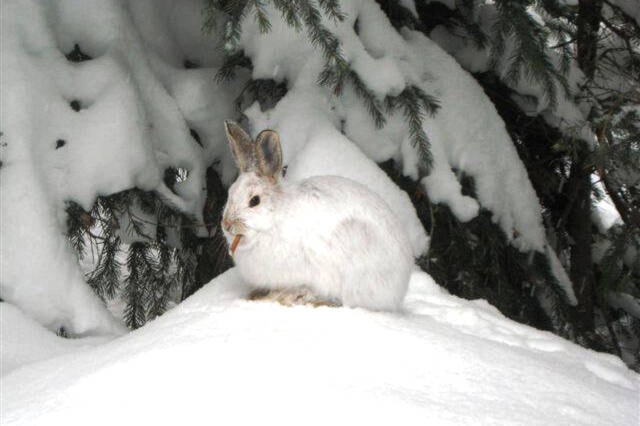Roseanne Van Ee
Okanagan Nature Nut
As we shelter ourselves in our warm homes this winter, where’s the wildlife?
Ground squirrels hibernate underground whereas red squirrels don’t. When temperatures drop below -10 Celsius red squirrels snuggle into their tree nests and go into a mini hibernation called torpor until it warms up.
Deer, moose and elk grow insulating soft, dense fur under their hair for winter.
Marmots, bears and many other animals store body fat to retain heat and store energy.
Voles develop a thick fur coat and lose weight at the beginning of winter limiting their eating for the duration of the season.
Snow insulates guaranteeing survival for many animals and plants.
Mice, shrews, voles, pocket gophers and snow weasels all stay active in the tunnelled subnivean world under snow.
Owls and coyotes can hear and locate animals moving beneath the snow.
Ptarmigans and grouse dig caves into the snow up to 30 centimetres deep where it’s 10 C warmer than outside. They come out for buds, twigs and conifer needles that they can digest thanks to small pebbles in their gizzard that they ingest in the fall and special bacteria flora. Feathers on the ptarmigans feet act like snowshoes.
Wood frogs hide away under leaves. Their bodies combine glucose and urea to create an antifreeze. Their breathing, heartbeat and blood circulation stops when temperatures plunge, but remarkably they don’t die. Their blood sugar skyrockets. As soon as temperatures climb above freezing their heart and lungs revive as if nothing had happened.
Bats hibernate hanging upside down in caves, attics or tree cavities. Some of our bat species migrate to slightly warmer climates to hibernate.
Honeybees form a large winter cluster around the queen bee in their hives. They vibrate their wing muscles to create warmth and constantly move around. Warm bees inside the cluster move to the outer layer pushing the cooler ones inward. They fortify themselves with the summer gathered honey or a sugar replacement from beekeepers. As soon as outdoor temperatures warm, bees leave the hive to relieve themselves. Some of our native bee species migrate.
Some animals can even survive freezing. Beetles can freeze up to six hours.
Ducks, swans and other waterfowls’ webbed feet are so cold that they don’t stick to the ice.
Some birds migrate, whereas our resident birds protect themselves by sheltering in trees or shrubs. They grow downy feathers and fluff up on cold days giving them a chubby appearance.
Varying hares turn into camouflaged white snowshoe hares that bound effortlessly over the snow.
Overwintering butterflies and moths tuck under tree bark.
How will our wildlife manage with climate change; with extreme and unpredictable weather conditions? Very few are as adaptable as us.
READ MORE: Okanagan Nature Nut: Co-existing with coyotes requires caution
READ MORE: 26 cow carcasses removed from Okanagan Lake
@VernonNews
newsroom@vernonmorningstar.com
Like us on Facebook and follow us on Twitter
